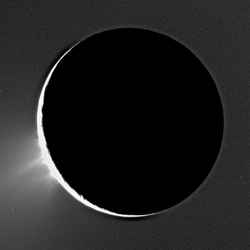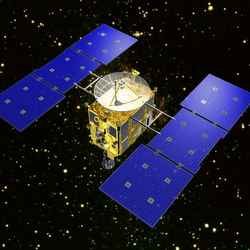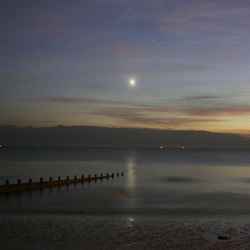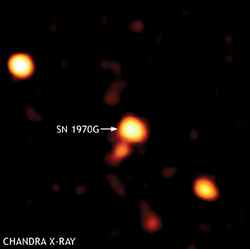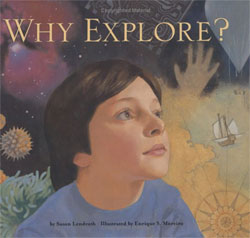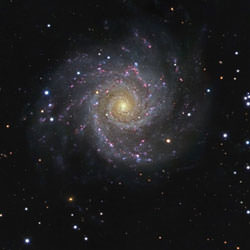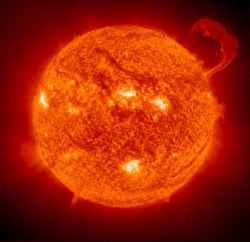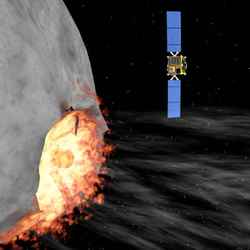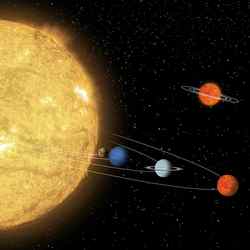
An artist’s concept of the miniature solar system (top) compared to a known solar sytem. Image credit: NASA/JPL Click to enlarge
Scientists using a combination of ground-based and orbiting telescopes have discovered a failed star, less than one-hundredth the mass of the Sun, possibly in the process of forming a solar system. It is the smallest known star-like object to harbor what appears to be a planet-forming disk of rocky and gaseous debris, which one day could evolve into tiny planets and create a solar system in miniature. A team led by Kevin Luhman, assistant professor of astronomy and astrophysics at Penn State University, will discuss this finding in the 10 December 2005 issue of Astrophysical Journal Letters.
The discovered object, called a brown dwarf, is described as a “failed star” because it is not massive enough to sustain nuclear fusion like our Sun. The object is only eight times more massive than Jupiter. The fact that a brown dwarf this small could be in the midst of creating a solar system challenges the very definition of star, planet, moon and solar system.
“Our goal is to determine the smallest ‘sun’ with evidence for planet formation,” said Luhman. “Here we have a sun that is so small it is the size of a planet. The question then becomes, what do we call any little bodies that might be born from this disk: planets or moons?” If this protoplanetary disk does form into planets, the whole system would be a miniaturized version of our solar system — with the central “sun”, the planets, and their orbits all roughly 100 times smaller.
Luhman’s team detected the brown dwarf, called Cha 110913-773444, with NASA’s Spitzer Space Telescope, the Hubble Space Telescope, and two telescopes in the Chilean Andes, the Blanco telescope of the Cerro Tololo Inter-American Observatory and the Gemini South telescope, both international collaborations funded in part by the National Science Foundation. Luhman led a similar observation last year that uncovered a 15-Jupiter-mass brown dwarf with a protoplanetary disk.
Brown dwarfs are born like stars, condensing out of thick clouds of gas and dust. But unlike stars, brown dwarfs do not have enough mass — and therefore do not have enough pressure and temperature in their cores — to sustain nuclear fusion. They remain relatively cool objects visible in lower-energy wavelengths such as infrared. A protoplanetary disk is a flat disk made up of dust and gas that is thought to clump together to form planets. Our solar system was formed from such a disk about five billion years ago. NASA’s Spitzer telescope has found dozens of disk-sporting brown dwarfs so far, several of which show the initial stages of the planet-building process. The material in these disks is beginning to stick together into what may be the “seeds” of planets.
With Spitzer, the science team spotted Cha 110913-773444 about 500 light years away in the constellation Chamaeleon. This brown dwarf is young, only about 2 million years old. The team studied properties of the brown dwarf with infrared instruments on the other observatories. The cool, dim protoplanetary disk was detectable only with Spitzer’s Infrared Array Camera, which was developed at the Harvard-Smithsonian Center for Astrophysics.
In the past decade, advances in astronomy have led to the detection of small brown dwarfs and massive extra-solar planets, which has brought about a quandary in taxonomy. “There are two camps when it comes to defining planets versus brown dwarfs,” said team member Giovanni Fazio of the Harvard-Smithsonian Center for Astrophysics. “Some go by size, and others go by how the object formed. For instance, this new object would be called a planet based on its size, but a brown dwarf based on how it formed.” If one were to call the object a planet, Fazio said, then Spitzer may have discovered its first “moon-forming” disk. No matter what the final label may be, one thing is clear: The universe produces some strange solar systems very different from our own. Other members of the discovery team are Lucia Adame and Paola D’Alessio of the National Autonomous University of Mexico and Nuria Calvet and Lee Hartmann of the University of Michigan.
The 4-meter Blanco Telescope at the Cerro Tololo Inter-American Observatory in Chile is part of the National Optical Astronomy Observatory, which is operated by the Association of Universities for Research in Astronomy (AURA) Inc. under a cooperative agreement with the National Science Foundation. The nearby 8-meter Gemini South telescope also is managed by AURA. NASA’s Goddard Space Flight Center, Greenbelt, Md., built Spitzer’s Infrared Array Camera. The instrument’s principal investigator is Giovanni Fazio. The Jet Propulsion Laboratory, Pasadena, Calif., manages the Spitzer mission for NASA. Science operations are conducted at the Spitzer Science Center at the California Institute of Technology in Pasadena.
Original Source:Penn State University

